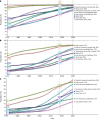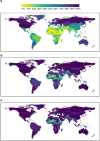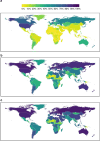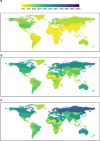Measuring and forecasting progress towards the education-related SDG targets
- PMID: 32350468
- PMCID: PMC7332421
- DOI: 10.1038/s41586-020-2198-8
Measuring and forecasting progress towards the education-related SDG targets
Abstract
Education is a key dimension of well-being and a crucial indicator of development1-4. The Sustainable Development Goals (SDGs) prioritize progress in education, with a new focus on inequality5-7. Here we model the within-country distribution of years of schooling, and use this model to explore educational inequality since 1970 and to forecast progress towards the education-related 2030 SDG targets. We show that although the world is largely on track to achieve near-universal primary education by 2030, substantial challenges remain in the completion rates for secondary and tertiary education. Globally, the gender gap in schooling had nearly closed by 2018 but gender disparities remained acute in parts of sub-Saharan Africa, and North Africa and the Middle East. It is predicted that, by 2030, females will have achieved significantly higher educational attainment than males in 18 countries. Inequality in education reached a peak globally in 2017 and is projected to decrease steadily up to 2030. The distributions and inequality metrics presented here represent a framework that can be used to track the progress of each country towards the SDG targets and the level of inequality over time. Reducing educational inequality is one way to promote a fairer distribution of human capital and the development of more equitable human societies.
Conflict of interest statement
The authors declare no competing interests.
Figures







Comment in
-
Too many children miss out on education - but better data can help.Nature. 2020 Apr;580(7805):564. doi: 10.1038/d41586-020-01263-2. Nature. 2020. PMID: 32346147 No abstract available.
References
-
- UNESCO. Migration, Displacement and Education: Building Bridges, not Walls. https://en.unesco.org/gem-report/report/2019/migration (2018).
-
- Marmot, M., Friel, S., Bell, R., Houweling, T. A. & Taylor, S. Closing the gap in a generation: health equity through action on the social determinants of health. Lancet372, 1661–1669 (2008). - PubMed
-
- Gakidou, E., Cowling, K., Lozano, R. & Murray, C. J. Increased educational attainment and its effect on child mortality in 175 countries between 1970 and 2009: a systematic analysis. Lancet376, 959–974 (2010). - PubMed
Publication types
MeSH terms
Grants and funding
LinkOut - more resources
Full Text Sources
Miscellaneous

